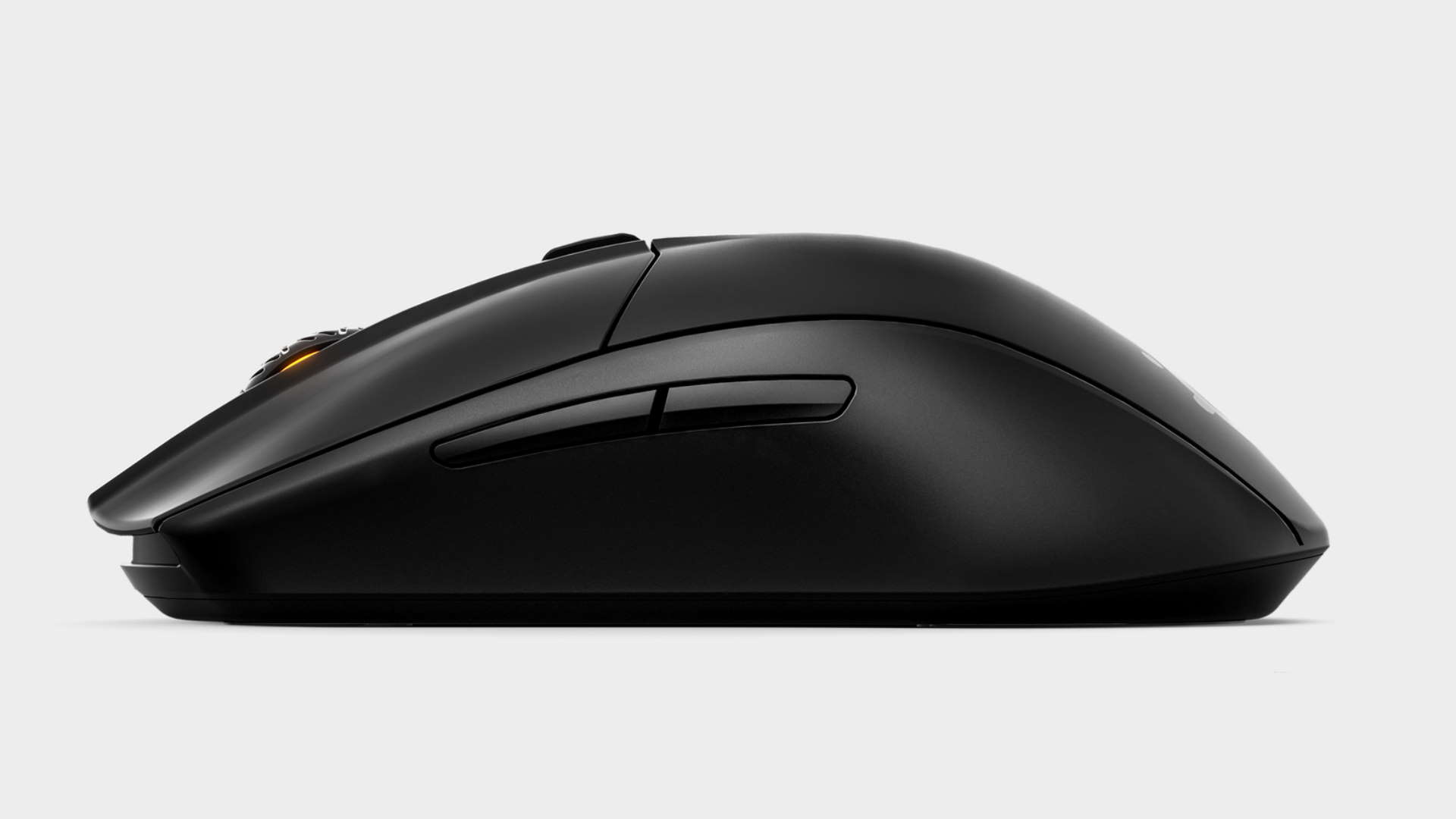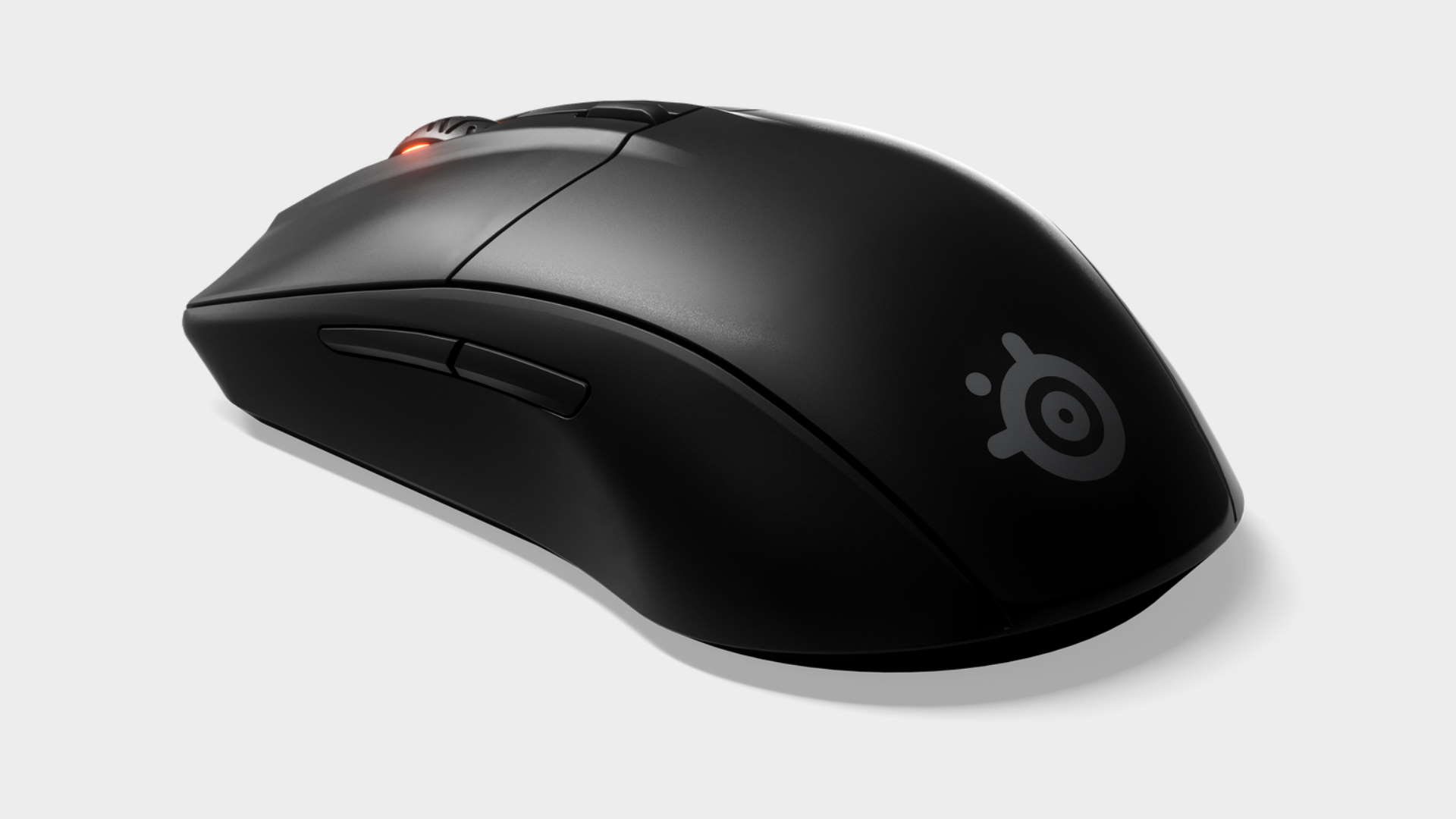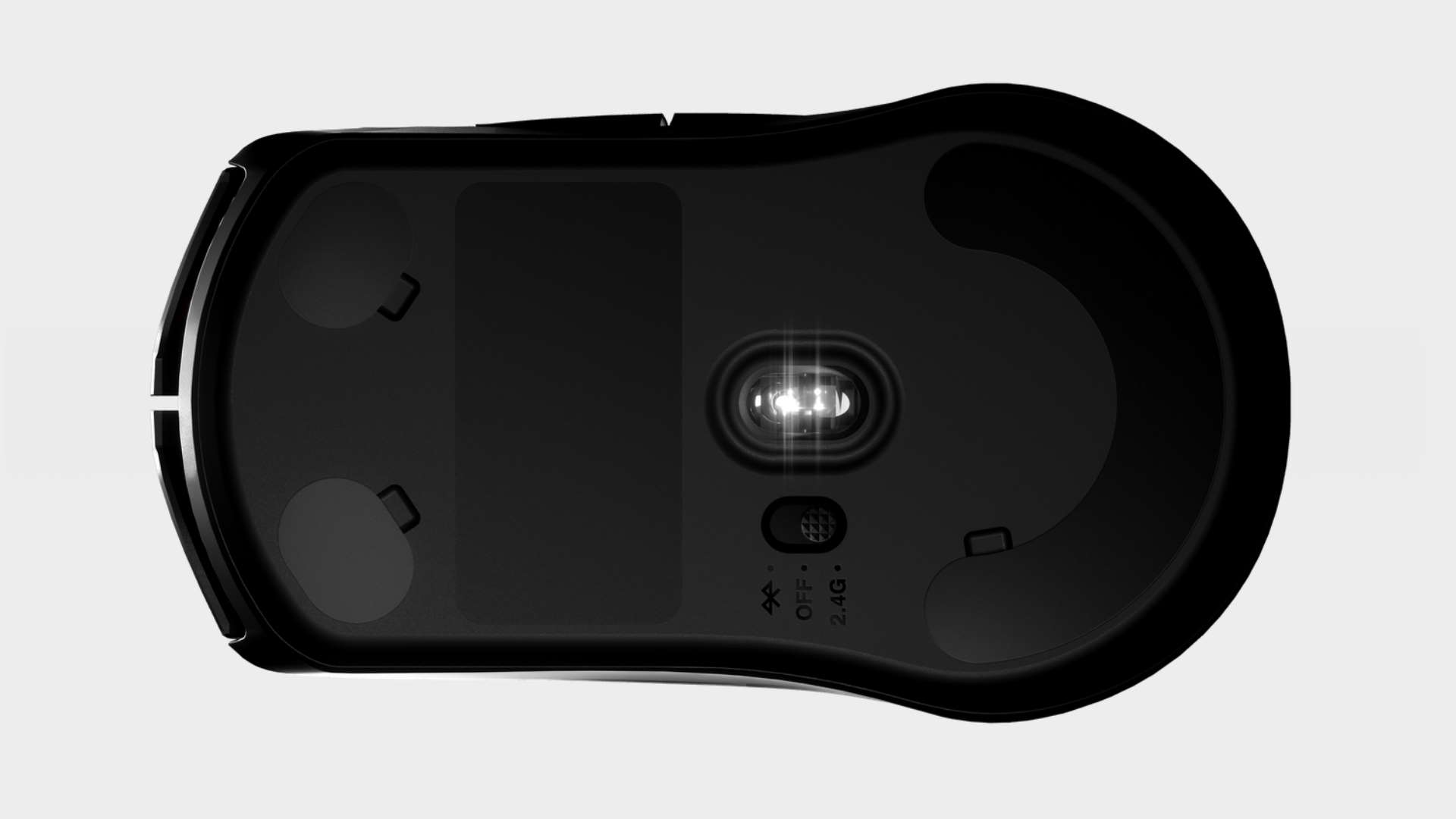SteelSeries Rival 3 Wireless gaming mouse review
The SteelSeries Rival 3 Wireless gaming mouse is an affordable, entry level mouse. It's sturdy and sleek, completely wireless, and has two different options for connectivity (which we'll get into in just a moment). But these seemingly marvellous features are bracketed by some caveats to its fundamentals that drive it a little down the scoreboard.
One of the biggest selling points for this mouse, which contributes to its miniscule weight, is that it is meant to be totally wireless. In fact you can't even plug in a USB cable to charge as it runs on AAA batteries. It can be powered by either two AAA batteries, or one alone. Packing one in there obviously removes some weight, but will half the battery life, so you'll have to weigh up the options for yourself. Using a single battery doesn't affect actual performance at least, unless that extra .6oz makes aiming impossible for you.
Not having to ship with a rechargeable battery does make it cheaper to manufacture, and so has reduced the price of purchase. The downside being you'll have to keep stocked up on batteries, I guess. Then there's the year-long battery life promise from SteelSeries, which will depend entirely on which batteries you use—it does come with some included but someone in the office lost them. Either way, the choice to drop the ability to charge entirely doesn't seem to add much to the product.
When it comes to tracking the battery usage, there's another hurdle. In the SteelSeries 3 Engine, which I otherwise have no gripes with, it only shows a three-bar battery indicator for each product—not the most accurate reading ever. Still, the Duracell ultra batteries I popped in over a week ago haven't shown a drop in that time; that's after using it all day every day for work, and the odd evening gaming session. This is with the sleep timer set to 1.5 mins, High-Efficiency Mode off, and Illumination Smart Mode on. I was a little sceptical about the year long battery life claims but it's not like I've had a year to test it, so I can't say for sure.
Rival 3 Spec
DPI: 18,000
Sensor: TrueMove Air sensor 18K
Battery: up to 2x AAA (included)
Interface: USB
Buttons: 6
Ergonomic: Right-handed
Weight: 1 battery - 3.1oz (89g) / 2 batteries - 3.7oz (107g)
Price: $49.99 (£54.99)
The software, other than the awkward battery reading, is pretty nifty: the features seem to be endless, with settings that govern everything you could want to tinker with. You've got space to set plenty of custom configurations, quick actions for each button (all of which are programmable), and an in-depth macro editor. Acceleration and deceleration are visualised with a sine wave, and there are options for angle snapping accuracy, as well as a bunch of battery saving options. The CPI setting caps at 18,000, with adjustable pre-set levels which can be cycled through, and the max polling rate is 1,000Hz.
All those options, topped with the accurate TrueMove Air sensor, add up to a smooth, responsive gaming experience. I tend to take shots at something like 900 CPI like a scrub, but for someone more skilled than I, this mouse is able to deliver in terms of accuracy. And it works around your personal preferences.
Sadly though, the full wealth of customisation options only work in 2.4G wireless mode. In Bluetooth mode, the software oddly lets you think you're editing the options until you read the little aside by the Bluetooth indicator. It explains that key bindings, acceleration and deceleration, and angle snapping will return to defaults in this mode. And there's no reading on battery life at all over Bluetooth. Oh, and your polling rate is nerfed at 125Hz, as well. Sad times for gaming.
But the Bluetooth connectivity feature in itself is nice as a backup option—say if you've run out of USB ports on your machine, lost the dongle, or just sat on the sofa and can't be arsed to get up and plug it in. Just don't expect much functionality, Bluetooth mode is only for standard clicking.



Anyway, whether you're standard clicking or absolutely thrashing the mouse around, it should be able to handle any amount of heavy handedness. Despite being relatively lightweight, the thing is sturdy. None of the buttons are flimsy, so no accidental clicking here, but the side buttons are pretty stiff straight out of the box. I find them difficult to press without excessive force, which is no good in a fast-paced gaming environment.
The design is much nicer than a lot of lightweight mice, though. It's unassuming and slick, with a non perforated black plastic chassis with a hump in the middle, and it tapers toward the front but juts out with what I'm going to call the mouse's hips toward the back. All this lends itself to use with a claw grip, or palm grip at a push. A very straight palm grip for small hands, though. I'm used to using a more curved ergonomic shape, and switching to this had my little hands a bit confused. But now I'm getting used to it, the hipped design does really work for flinging the mouse around at top speed.
As far as RGB aesthetic, it has very limited lighting features, with just a single RGB zone emanating from either side of the scroll wheel. It does, however, include a few cute lighting effects including "trigger," which fires off a different colour when you click. Unfortunately the colours aren't super accurate, but these kinds of limitations are to be expected in such an affordable, lightweight mouse.
So, despite the few gripes I have with this mouse it does have its plus sides. It's a gaming mouse best for the budget-conscious gamers among us who need something sturdy to fling around in the heat of battle, and don't want to ever worry about wires, or smashing the thing into pieces in a rage. I would recommend using the wireless dongle, so make sure you have a spare USB slot for it—don't go into this expecting a masterful Bluetooth solution. That said, it does most of what it's meant to do, and for a sub $50 price tag, which ain't so bad.
from PCGamer latest https://ift.tt/2NwHGkq
The SteelSeries Rival 3 Wireless gaming mouse is an affordable, entry level mouse. It's sturdy and sleek, completely wireless, and has two different options for connectivity (which we'll get into in just a moment). But these seemingly marvellous features are bracketed by some caveats to its fundamentals that drive it a little down the scoreboard.
One of the biggest selling points for this mouse, which contributes to its miniscule weight, is that it is meant to be totally wireless. In fact you can't even plug in a USB cable to charge as it runs on AAA batteries. It can be powered by either two AAA batteries, or one alone. Packing one in there obviously removes some weight, but will half the battery life, so you'll have to weigh up the options for yourself. Using a single battery doesn't affect actual performance at least, unless that extra .6oz makes aiming impossible for you.
Not having to ship with a rechargeable battery does make it cheaper to manufacture, and so has reduced the price of purchase. The downside being you'll have to keep stocked up on batteries, I guess. Then there's the year-long battery life promise from SteelSeries, which will depend entirely on which batteries you use—it does come with some included but someone in the office lost them. Either way, the choice to drop the ability to charge entirely doesn't seem to add much to the product.
When it comes to tracking the battery usage, there's another hurdle. In the SteelSeries 3 Engine, which I otherwise have no gripes with, it only shows a three-bar battery indicator for each product—not the most accurate reading ever. Still, the Duracell ultra batteries I popped in over a week ago haven't shown a drop in that time; that's after using it all day every day for work, and the odd evening gaming session. This is with the sleep timer set to 1.5 mins, High-Efficiency Mode off, and Illumination Smart Mode on. I was a little sceptical about the year long battery life claims but it's not like I've had a year to test it, so I can't say for sure.
Rival 3 Spec
DPI: 18,000
Sensor: TrueMove Air sensor 18K
Battery: up to 2x AAA (included)
Interface: USB
Buttons: 6
Ergonomic: Right-handed
Weight: 1 battery - 3.1oz (89g) / 2 batteries - 3.7oz (107g)
Price: $49.99 (£54.99)
The software, other than the awkward battery reading, is pretty nifty: the features seem to be endless, with settings that govern everything you could want to tinker with. You've got space to set plenty of custom configurations, quick actions for each button (all of which are programmable), and an in-depth macro editor. Acceleration and deceleration are visualised with a sine wave, and there are options for angle snapping accuracy, as well as a bunch of battery saving options. The CPI setting caps at 18,000, with adjustable pre-set levels which can be cycled through, and the max polling rate is 1,000Hz.
All those options, topped with the accurate TrueMove Air sensor, add up to a smooth, responsive gaming experience. I tend to take shots at something like 900 CPI like a scrub, but for someone more skilled than I, this mouse is able to deliver in terms of accuracy. And it works around your personal preferences.
Sadly though, the full wealth of customisation options only work in 2.4G wireless mode. In Bluetooth mode, the software oddly lets you think you're editing the options until you read the little aside by the Bluetooth indicator. It explains that key bindings, acceleration and deceleration, and angle snapping will return to defaults in this mode. And there's no reading on battery life at all over Bluetooth. Oh, and your polling rate is nerfed at 125Hz, as well. Sad times for gaming.
But the Bluetooth connectivity feature in itself is nice as a backup option—say if you've run out of USB ports on your machine, lost the dongle, or just sat on the sofa and can't be arsed to get up and plug it in. Just don't expect much functionality, Bluetooth mode is only for standard clicking.



Anyway, whether you're standard clicking or absolutely thrashing the mouse around, it should be able to handle any amount of heavy handedness. Despite being relatively lightweight, the thing is sturdy. None of the buttons are flimsy, so no accidental clicking here, but the side buttons are pretty stiff straight out of the box. I find them difficult to press without excessive force, which is no good in a fast-paced gaming environment.
The design is much nicer than a lot of lightweight mice, though. It's unassuming and slick, with a non perforated black plastic chassis with a hump in the middle, and it tapers toward the front but juts out with what I'm going to call the mouse's hips toward the back. All this lends itself to use with a claw grip, or palm grip at a push. A very straight palm grip for small hands, though. I'm used to using a more curved ergonomic shape, and switching to this had my little hands a bit confused. But now I'm getting used to it, the hipped design does really work for flinging the mouse around at top speed.
As far as RGB aesthetic, it has very limited lighting features, with just a single RGB zone emanating from either side of the scroll wheel. It does, however, include a few cute lighting effects including "trigger," which fires off a different colour when you click. Unfortunately the colours aren't super accurate, but these kinds of limitations are to be expected in such an affordable, lightweight mouse.
So, despite the few gripes I have with this mouse it does have its plus sides. It's a gaming mouse best for the budget-conscious gamers among us who need something sturdy to fling around in the heat of battle, and don't want to ever worry about wires, or smashing the thing into pieces in a rage. I would recommend using the wireless dongle, so make sure you have a spare USB slot for it—don't go into this expecting a masterful Bluetooth solution. That said, it does most of what it's meant to do, and for a sub $50 price tag, which ain't so bad.
via IFTTT

Post a Comment